A writing conference, like any type of one-on-one instruction, can be truly powerful.
It gives us an opportunity to pause and really notice what a child is doing. We see where they are with their writing. We better understand how they feel about writing.
And it also gives us a chance to provide just-right instruction. Because we all know that what we teach in whole group or even small group just can’t reach all of our students every single day.
I’ve always valued one-on-one writing conferences. But actually making them happen has been a challenge for me.
Before I became a literacy specialist, I taught grades Pre-K through 2nd. And I spent most of that time teaching Kindergarten. I struggled with questions like these:
- How many students should I confer with each day?
- How often should I meet with my struggling writers?
- What should happen during a conference?
- How will I know what to teach during a conference?
- How do I get my kids to work independently so that I can stop putting out fires and actually have time to confer?
In this post, I’ll share my own answers to all of these questions, as well as what I’ve learned from some outstanding professional development books (see my references section for some good reads). My answers may not provide perfect solutions for you, but I hope that they will at least get you thinking about what might work in your own classroom.
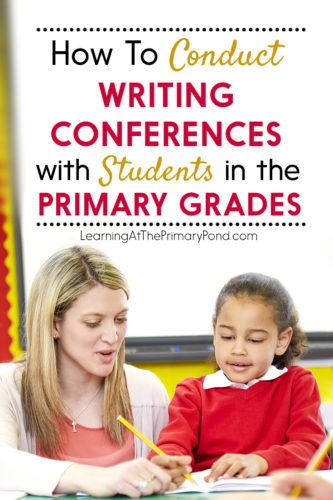
Photo Credit: Monkey Business Images, Shutterstock
How many students should I confer with each day?
You should confer with all of your students every single day.
…….JUST KIDDING! 🙂
Unless you have about 5 kids in your class, you will make yourself crazy if you try to meet with all of your students every day! I know that I couldn’t possibly have meaningful conversations if I tried to meet with every child just for the sake of doing so.
Instead, I select just a few students to confer with each day.
I do try to have a “touch point” with most students throughout the day’s workshop – but that can be by calling on them during a minilesson, smiling and making eye contact during independent writing time, “calling them out” for good behavior/good writing, flashing a quick “thumbs up,” having them share with the class during sharing time, and so on.
I want every child to feel “noticed” – but that doesn’t have to be through a writing conference.
But back to the original question – how many students should we confer with each day? I wish I could give you a solid number, but that answer is “it depends.”
It depends on:
- How long your independent writing time is each day
- How many small groups you’re meeting with that day
- Where you are in the school year
- If you are launching a unit, in the middle of a unit, or finishing up a unit
A “typical” conference usually lasts 4-5 minutes for me. (Use a timer! This has really helped me stay on track during conferences!)
If your independent writing time is about 25 minutes long, then you might get through 4, maybe 5 students each day.
But then there’s the consideration of small groups. Although I love individual writing conferences, small group instruction can be a more efficient way of meeting students’ needs (more on small groups in next week’s blog post). So you might have fewer individual conferences because you spend some of your time teaching a small group.
You also have to think about where you are in your school year. At the beginning of the school year (especially in Kinder), I get through very few writing conferences each day. For the first couple of weeks, I don’t do writing conferences at all. And after a long holiday break, I scale back the number of conferences I conduct so that I can get kids re-settled in their routines.
Last, the number of conferences you’ll conduct will also depend upon where you are in a particular unit. If you use my writing units, then you know that I like to give kids more guidance in getting started at the very beginning of the unit. We move through the processes of brainstorming and drafting in a more uniform way at the very beginning.
During that first part of the unit, I do briefer “check in” conferences to make sure that everyone is on the right track. It’s not a good use of my time to help only 4-5 students if the other 15-20 are floundering! For the first couple of days that we’re working in a new unit or genre, I usually forego my typical conferences so that I can check in with a greater number of students.
As students get the hang of things (and are all working on different pieces, and are at different places in the writing process), I go back to my usual number of conferences and small groups.
But when we’re ready to wrap up a unit, the balance shifts again. Kids may need help getting their writing polished up for publication, so I do more check-ins than true conferences. (This only lasts for a day or two).
So….now you understand why I don’t have a simple answer to this question. It really depends upon so many factors!
The one thing I always try to do is to confer with all of my writers either individually or in a small group throughout the week. And if I only meet with a child in a small group setting one week, then I try to balance that out with an individual conference the following week.
If you’re struggling with balancing individual and small group instruction during writing workshop, check out this post for more ideas. That post is about reading workshop, but many of the same principles apply.
And here’s a free PDF that you can use for tracking your writing instruction over time (click on the image below to download). I usually track how I meet with students for 2-3 weeks, and then I take a look at the “big picture,” using this sheet:
How often should I meet with my struggling writers?
Again, my answer is, “it depends.” (Sorry!!) I do try to meet with my struggling writers more often than I do with those students who can work more independently. But it doesn’t mean that I spend the majority of my time with students who struggle.
Often, I will schedule conferences and small group instruction for these students (just as I do with all of my students) but also plan for more frequent “check-ins.” A check-in is not a complete writing conference. I just pop over to see how the writer is doing – and then I give a quick compliment or maybe remind the student to apply a strategy we discussed in a previous conference. This doesn’t take more than one minute.
Sometimes I have students in my class who consistently have trouble getting started. Instead of running back and forth between them at the start of independent writing time, I have them begin work time at my small group table.
They all grab their writing folders and sit down at the table to begin working. While the other students are getting settled and beginning their work, I sit down with that small group and help them start writing. I may have them read their work from a previous day to a partner, do a little oral storytelling, or simply give them a nudge to get going again. I’m not teaching them anything new – the purpose of this “get going” group is just to, well, get them going!
Then, once a child is writing successfully, I dismiss her to return to her seat and continue writing independently. Within a period of 5-7 minutes, all of the students should have been dismissed so that I can begin conferences and small group instruction.
If you want to try out a “get going” group in your own classroom, be sure that students don’t become overly dependent upon this support. Over time, conduct your “get going” groups less often (maybe alternating days, eventually just once a week, and then only on an as-needed basis). Eventually, the goal is for the kids to be able to get going on their own. So don’t forget to remove the scaffold!
What should happen during a conference?
Generally speaking, my conferences (both reading and writing) follow this series of 3 components:
- Observe
- Compliment
- Teach
The “observe” component:
When I first sit down to confer with a child (and I do literally sit down on a chair – I used to stand or crouch, but sitting is more comfortable and puts me at eye level with the child), I observe what she is working on, what strategies she is using/not using, etc.
I may have the student read aloud a portion of her writing to me (this is especially helpful if you teach students who aren’t yet spelling traditionally!). Or I may quickly skim the piece of writing silently. Or I may ask her if she’s applying a certain concept or strategy to her writing (and if so, how).
During this observation component, I’m trying to gather information. I want to figure out what my compliment is going to be, as well as what I’m going to teach during the rest of the conference. I may also jot down anecdotal notes or complete part of a checklist.
Sometimes, however, this observation component actually happens before the conference begins. I may have picked up the child’s writing folder the previous night and read through it, so I already know that she needs to work on writing strong introductions.
Choosing the focus of the conference beforehand can be very helpful in saving time. When I already know my compliment and teaching point, then I just skip the observation component entirely. (However, if the child has a concern or question, you may need to save your plans for another time. I think it’s important that we are flexible enough to recognize what’s important in the moment, even if it means deviating from our original intentions.)
Oh, and one last thing about observing – don’t forget to respond to the content of the child’s writing as a reader! If the piece made you laugh, say so. If the child is writing about something sad or difficult, express your concern. If you can relate to the piece of writing or a challenge the child is having, make a comment about this.
I say this because I am guilty of thinking SO hard about what my compliment and teaching point that I completely forget to respond to the writing as a human being. Kids need to hear your reactions as a reader – they are not little writing robots, so we have to avoid becoming teaching robots, too. 🙂
The “compliment” component:
I like to think of this part as a “Keep doing x” rather than just an opportunity to say “good job!” Because I want to provide positive feedback and build a relationship with the child – but I also want the student to continue doing the “good thing!”
For example, if a student is successfully using transition words, I might say something like: “Wow, you are really using our transition words anchor chart! I see you’ve included ‘first,’ ‘next,’ and ‘also,’ in your piece. This helps the reader understand that you have three different ideas to share. I know you will continue using transition words in other pieces you work on, too. Keep up the good work!”
I could have said, “Good job using transition words!” But instead, I reinforced the student’s use of an anchor chart, explained why it was important, and encouraged her to continue doing it – all in just a few sentences.
If we’re being completely honest with ourselves, sometimes it’s hard to come up with a compliment for a student. We notice that a writer has been goofing off and barely has anything down on the page – and what IS written is completely incorrect!
In order to give a compliment and provide students with the affirmation that many of them so desperately need, we have to train ourselves to momentarily look past all those mistakes. Here’s a quote that I love about this topic:
On p. 17 of their book Conferring with Young Writers (2016), Kristin Ackerman and Jennifer McDonough quote Ayres and Overman (2013, 87-88):
We choose joy about the excess of periods in a student’s writing, because a month ago there were none. We choose joy about the three meager lines of writing, because yesterday there were crushed pencil points and tears. We choose joy about the misspellings, because all the sight words are accurate. In the face of so much need, we can make a choice to celebrate.
I know it feels nearly impossible some days – but when I choose joy, it’s better for both the student and me.
The “teach” component
During this part of the lesson, I choose a strategy to teach the student that’s within reach. I can:
- Encourage the student to try out a new strategy that she’s not applying yet (one that would be applicable to her work)
- Encourage the student to focus on using a strategy consistently, if she’s using it inconsistently right now
- Follow up on previous instruction by reminding the student how to apply a strategy OR encouraging the student to apply the strategy in a new way
I might start by saying…
- I noticed that…
- Do you remember the lesson where I showed…
- Your piece reminds me of the mentor text…
- Have you ever thought about trying…
- Let’s look at the anchor chart titled…
I also explicitly state what I want the student to try, and I’ll give an example. The example can come from a published book, a piece of writing we did as a class, a piece of writing I modeled during a lesson, an exemplar from another student, or a sample mentor text I create (check out this resource for lots of sample mentor texts you can use for this purpose).
I may also do some writing to show the student what I mean. BUT I don’t write on students’ work. This is my personal preference – I want to give kids ownership over their writing. They have the final say in whether or not they use a certain strategy. So I write down ideas on a sticky note, and the child can choose to include them (or not).
Last, I have the student try out the teaching point in some way. This may be by adding to or correcting her own work, or by writing something on a sticky note that she might choose to include later. (If it’s a strategy that the child REALLY needs to use, and it’s a non-negotiable, I will request that she fix her own work right then and there, and it’s not a choice.)
At that point, I give some sort of encouraging statement (“Keep using the _____ strategy as you write! Thanks for showing me what you are working on today!”) and move on.
Whew! As you can see, this is a LOT of stuff to fit into just five minutes. So when I sit down to confer, I need to have my “stuff” all ready to go. There’s no time to run around the room searching for my clipboard (definitely guilty of doing that).
So I like to keep a conferring tote bag for my writing conferences. In the bag, I place:
- Sticky notes
- Writing utensils
- Anecdotal note forms and previous notes
- Mentor texts (published books, student samples, my own samples, etc.)
- A notebook (if I’m working with 2nd grade and up, so that I have more room to write than what fits on a sticky note)
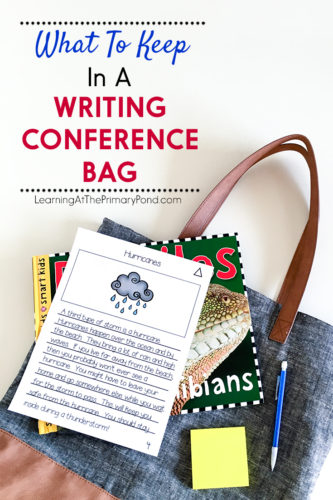
How will I know what to teach during a conference?
Now that we’ve gone over the different parts of a conference, you might be wondering what you should teach during the actual conference! I will be going more in-depth on this topic in a post two weeks from now. However, here are some tips to get you started:
- Choose a SINGLE focus. Don’t try to teach more than one thing at a time!
- Focus on your unit goals. Keep a checklist or rubric next to you that you can quickly scan if a teaching point doesn’t come to you immediately.
- Remember that you can teach a strategy more than one time! Most kids (especially our little ones) need lots of reinforcement. You can have 2-3 conferences with one child on the same strategy!
- Make a plan beforehand for your conferences. You can determine what to teach by reading students’ writing or by reviewing your own anecdotal notes from previous conferences. Sometimes, your plan may be to just observe and decide on a teaching point during the actual conference.
When I’m conferring with a student and need to choose a teaching point, the easiest thing for me to do is focus on writing conventions.
Missing periods, or misspelled words, or incorrect capitalization just jumps off the page at me. I see those mistakes immediately, and I don’t really have to think about what to teach.
However, as important as correct conventions are, many of our writing conferences should focus on content. We have to be able to intentionally ignore the misused question marks and think about the strength of the introduction, the absence of a conclusion, the use of transition words, inclusion of details, etc. These content-focused lessons are what can really move our students forward in their writing.
How do I get my kids to work independently so that I can stop putting out fires and actually have time to confer?
Gosh, this question alone could fill up so many blog posts! But in a nutshell….getting kids to “leave you alone” so you can confer comes down to establishing consistent routines and classroom management.
Whether you’re establishing routines for the school year or reworking your workshop mid-year, brainstorm possible problems that students may encounter. These can include things like…
- Getting stuck or not knowing what to write about
- Not knowing how to spell a word
- Needing a drink/bathroom break
- Running out of paper
- Needing a new pencil or eraser
- Ripping a piece of writing
- Being bothered by a peer
Plan a lesson about each problem that you come up with. During the lesson, work with students to create an anchor chart that the kids can use to solve these problems (independently!) in the future.
And when the problem actually arises for a student, require the student to use the anchor chart to solve it! If you solve the problem for the student (or even just suggest a solution), she’ll learn to rely on you and continue interrupting your conferences.
Also, remember that it’s okay to backtrack at any point during the year. Decrease the amount of time students write independently. Revisit those expectations. Stop conferring and meeting with small groups so that you can focus on classroom management. The time you spend establishing procedures will pay off immensely in the future!
In addition to establishing a strong management system, giving students supportive tools will also help them work more independently, thereby freeing you up to confer. Differentiated writing paper (which I’ll talk more about in future posts) and supports like an alphabet chart or checklist can make a big difference in how much students can accomplish independently.
My free writing folder set includes tools like an alphabet chart, vowel chart, genre mini-anchor chart, checklists, and more. If you don’t already have it, get it HERE!
Conclusions
This was a long post, considering it’s about an instructional practice that takes only 5 minutes! But I think that this just goes to show how complex writing conferences really are.
Conferring, whether it’s during reading or writing, is something I’m always working on. Give yourself some grace if your conference accidentally takes 10 minutes. Or if you start with only one conference per day.
Small steps in the right direction can make a big difference for your students. Happy teaching!
References
Ackerman, K., & McDonough, J. (2016). Conferring with Young Writers. Portland, ME: Stenhouse Publishers.
Mermelstein, L. (2013). Self-Directed Writers. Portsmouth, NH: Heinemann.


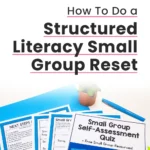

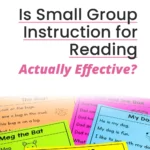

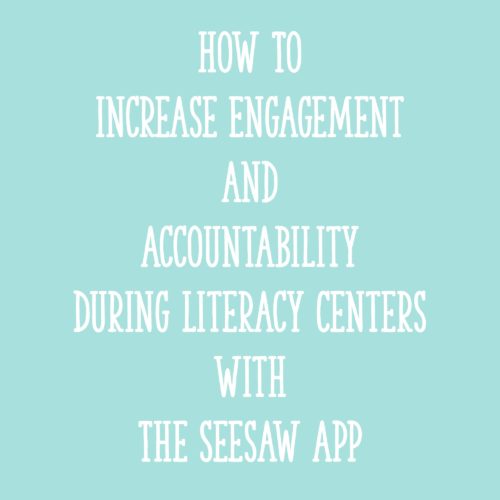
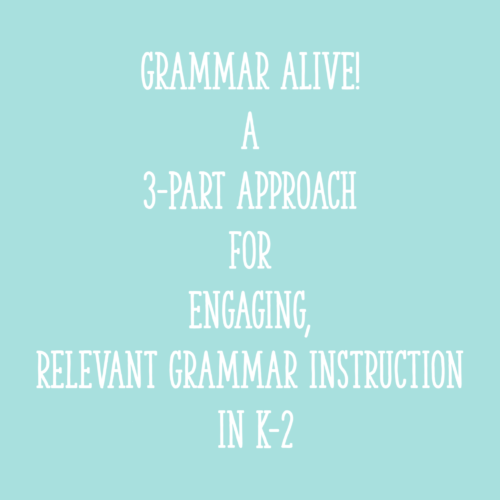






Ms. Aliso as a first year teacher. I found your post very helpful. Thank you for sharing. I love the writing folder!
I’m glad it was helpful!!
Alison
I love all of your helpful tips! We use Lucy Calkins for readers and writers workshops at my school. This is my 27th year and I still love teaching just as much as when I started.
I’m so glad! That’s awesome – what a blessing you must be to 27 classes of students!! 🙂
Thanks for reading!
Alison
Thanks, Mis. Alison. As a new lead teacher, I am grateful that you love sharing your expertise on teaching.
Abigail
As a new teacher your post was very helpful. I teach special education K-1 so it a lot more difficult to teach writing to children who struggle with writing but reading your post helps give me strategies/methods that I can utilize in my classroom. Thank you!